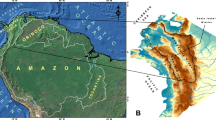Abstract
The evident effects of the thermal anomalies over the Tibetan Plateau (TP) and its vicinities are summarized and discussed in this paper. By the singular value decomposition (SVD) technique and numerical simulations of the effect of the snow depth anomaly over the TP, it is shown that the snow depth anomaly, especially in winter, is one of the factors influencing precipitation in China, and the winter snow anomaly is more important than the spring one. The relations between the sensible heat anomaly over the TP and the intensity of the South China Sea summer monsoon (SCSSM) are studied, too, and two key areas of the sensible heat anomaly over the TP are found. The relationships between the South Asia High (SAH) and the precipitation in the years with typical droughts or floods in the mid to lower valleys of the Yangtze River (MLVYR) and North China are investigated in some detail. It is found that not only the intensity of the SAH over the TP, but also the 100-hPa height in a large area influences the precipitation in the above two regions. The effects of the SAH on the onsets of the tropical Asian summer monsoon (TASM) including the SCSSM and the tropical Indian summer monsoon (TISM) are studied as well. It is found that the onset times of both the SCSSM and the TISM are highly dependent upon the latitudinal position of the SAH center.
Similar content being viewed by others
References
Ding Yuguo, and Jiang Zhihong, 1996: Generality of singular value decomposition in diagnostic analysis of meteorological fields.Acta Meteorologica Sinica,54, 365–372. (in Chinese)
Hahn, D. G., and S. Manabe, 1975: The role of mountains in the South Asia monsoon circulation.J. Atmos. Sci.,32, 1515–1541.
Huang Yanyan, and Qian Yongfu, 2004: Relationships between the South Asian High and characteristics of the typical droughts and floods in the mid to lower valleys of the Yangtze River and North China.Plateau Meteorology,23(1), 68–74.
Huang Yin, and Qian Yongfu, 2003: The relationships between the South Asian High and summer rainfall in North China.Plateau Meteorology,22(6), 602–607.
Kuo, H. L., and Y. Qian, 1982: Numerical simulation of the development of mean monsoon circulation in July.Mon. Wea. Rev.,110, 1879–1897.
Li Peiji, 1996: Discussion on the forcing of snow cover on the Qinghai-Xizang Plateau in simulation of Asian monsoon climate.Plateau Meteorology,15, 350–355. (in Chinese)
Qian Yongfu, Wang Siyu, and Shao Hui, 2001: A possible mechanism effecting the earlier onset of the South China Sea southwesterly summer monsoon compared to that of the Indian monsoon.Meteorology and Atmospheric Physics,76(3 and 4), 237–249.
Qian Yongfu, Yan Hong, Wang Qianqian, and Wang Anyu, 1988:Numerical Studies of Orographic Effects in the Planetary Atmosphere, Science Press, Beijing, 217pp. (in Chinese)
Qian Y., Y. Zheng, Y. Zhang, and M. Miao, 2003: Responses of China’s summer monsoon climate to snow anomaly over the Tibetan Plateau.International Journal of Climatology,23, 593–613.
Webster P. J., and S. Yang, 1992: Monsoon and ENSO: Selectively interactive systems.Quart. J. Roy. Meteor. Soc.,118, 877–926.
Wu Guoxiong, and Zhang Yongsheng, 1998: Thermal and mechanical forcing of the Tibetan Plateau and the Asian monsoon onset, Part I: Situating of the onset.Scientia Atmospherica Sinica,22, 825–838. (in Chinese)
Yao Yonghong, and Qian Yongfu, 2001: A study on the South China Sea monsoon index and the relationship between the index and regional rainfall of China.Journal of Nanjing University (Natural Sciences),37(6), 781–788. (in Chinese)
Zhang Yan, and Qian Yongfu, 2003: Impacts of surface sensible heat fluxes in the key areas of the Tibetan Plateau on interannual variation of the SCS summer monsoon intensity.Acta Meteorologica Sinica,17(Suppl.), 249–261.
Zheng Yiqun, Miao Manqian, and Qian Yongfu, 1999: Application of the turbulent kinetic energy scheme in the RegCM2 climate model.Acta Meteorologica Sinica,57, 641–650. (in Chinese)
Author information
Authors and Affiliations
Corresponding author
Rights and permissions
About this article
Cite this article
Yongfu, Q., Yan, Z., Yanyan, H. et al. The effects of the thermal anomalies over the Tibetan Plateau and its vicinities on climate variability in China. Adv. Atmos. Sci. 21, 369–381 (2004). https://doi.org/10.1007/BF02915565
Received:
Revised:
Published:
Issue Date:
DOI: https://doi.org/10.1007/BF02915565




